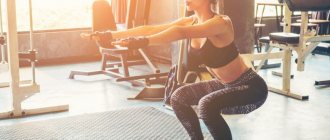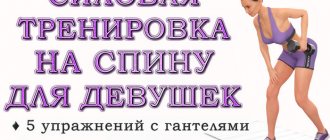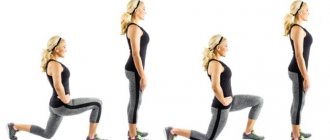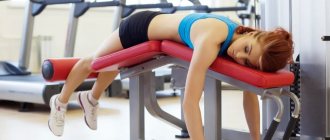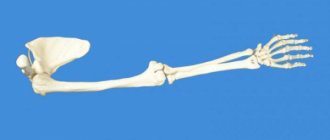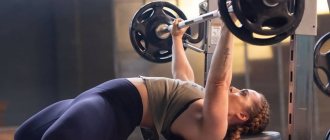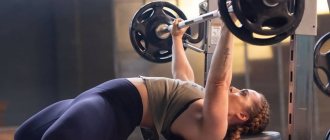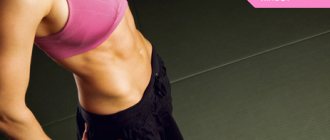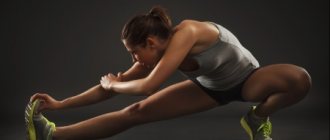© Vasyl — stock.adobe.com
Share:
What you need
- Barbell
- Dumbbells
- Exercise equipment
- Rubber shock absorber
Exercises for the buttocks are an important part of the training program for any athlete. This muscle group should be given attention not only by women who constantly care about the beauty of their body lines, but also by men.
In this article we will look at many important aspects for athletes that affect the training of this muscle group, and we will tell you how to pump up your buttocks at home and in the gym. Especially for our readers, we have collected in one material the best exercises for the buttocks that will make your body irresistible.
Anatomy of the gluteal muscles
Several muscles are responsible for the overall appearance of the buttocks. Every bodybuilder must know about the peculiarities of their structure so that in each specific case the most suitable and effective exercises can be selected. The gluteal group consists of three main sections - large, medium and small pairs of muscles.
© bilderzwerg — stock.adobe.com
Gluteus maximus muscle
This is the main part of the buttocks. It is diamond-shaped and located above the other gluteal areas. Its main function is extension and external rotation of the hip. When walking, the muscle is in a static position. The anatomical features of this section prevent unnatural tilts of the pelvic region and also contribute to shock absorption after a jump.
This muscle area should be worked by many athletes. A well-developed gluteus maximus muscle helps increase step frequency as well as dynamic work during hip extension. Track and field athletes, boxers, figure skaters, skiers and other athletes - it is important for all of them to properly pump the gluteus maximus muscle.
Gluteus medius muscle
This group is located on the side of the buttocks, located under the gluteus maximus. The main purpose is hip abduction and pelvic abduction with a fixed hip position. The zone actively takes part in the movement process. When walking, this area contracts on the supporting leg, which helps fix the pelvic area in place. The gluteal medial area can make it easier to lift your feet off the ground when walking.
This muscle is very important in many sports. Cross country athletes, gymnasts, figure skaters, and other athletes should work on increasing this muscle area.
Gluteus minimus
This muscle group is hardly noticeable. It is the deepest of the three. The main function is to abduct the hip and straighten the torso. This muscle area is involved in all running movements.
The gluteal muscles help stabilize the hip and are also especially active during cardio movements. In order to understand how to pump up your buttocks and make them more beautiful, you must effectively work out the large, middle and small muscles. Work hard. By pumping up your buttocks, you will be able to increase your strength in squats and will run and jump faster.
What are the dangers of uncontrolled loads?
Some believe that daily exercise will allow you to increase your hip size faster. This is wrong. Here are a few facts:
- An incorrectly selected weight of the barbell will cause unnecessary stress on the knees, which will subsequently lead to chronic diseases of the musculoskeletal system.
- Incorrect technique, especially when squats, is a direct path to knee injury. If you are a beginner, pay for the first month of training with a trainer who will advise you.
- Excessive physical activity will lead to chronic fatigue, deterioration in performance, and muscles will not have time to recover.
Intense strength training is prohibited without prior consultation with a cardiologist and diagnosis of possible diseases of the cardiovascular system.
Monitor your load using a heart rate monitor - your heart rate should be within the acceptable range, depending on your age. If the indicators exceed the norm, reduce the intensity of the workout.
Features of training for men and women
Training programs aimed at strengthening the buttocks are, in most cases, very similar. But there are still some features that influence the choice of exercises.
Workout for men
The main difference between men's training is that the emphasis is not only on giving the gluteal muscles a beautiful, toned shape, but is more aimed at developing strength qualities, increasing the volume of the legs and hips.
The advice on how to pump up a man’s buttocks is very simple - you need to work more with the barbell. Basic exercises for the buttocks used in weightlifting are perfect for this purpose. This way you will pump up several muscle groups at once. You can also work with dumbbells and kettlebells, and, of course, perform various deep squats.
When performing exercises with heavy sports equipment, it is very important to follow the correct technique, since most movements are quite traumatic.
Training for women
Girls and women do not attach as much importance to the development of strength qualities as men. They are more concerned about the beautiful and toned shape of the gluteal muscles. In this regard, lovely ladies, as a rule, are most often interested in the question of how to quickly pump up their buttocks. Especially if the beach season is just around the corner and there is little time left for training.
In order to get a toned butt, women can be advised to perform basic multi-joint exercises at home or in the gym. Don’t forget about isolation, as this way you focus the load on the gluteal muscle area. Thus, you must combine different types of loads.
If you really want to pump up your butt, and not just slightly tone it, you will need to do heavy strength exercises with maximum weight for yourself, and not just swing your legs at home on the mat. If you see a video like “how to make buttocks in 5 minutes at home,” be sure that such “training” will not have any effect. Don't be fooled by marketing phrases; building muscle is not easy work.
© liderina — stock.adobe.com
Useful tips
You won't be able to pump up your buttocks in one day. It actually takes a lot of hard work and dedication to achieve that round shape you're looking for, and you need to structure your workouts clearly and effectively.
Luckily, you don't have to guess anymore about what makes a big butt. We've rounded up some of our best, most useful butt-building tips. All of them come from trainers and experts who know a thing or two about strengthening the lower body.
Read: Exercises to reduce the size of the thighs and buttocks
Lift heavy weights
While it may be tempting to stick with strength training that focuses on moving your own body weight, experts say it's better to lift heavier weights if you want a bigger butt. Muscle growth occurs when you tense your muscles. Therefore, if the goal is to make the butt grow, it is necessary to strain it with resistance with a more complex weight than it was before.
This means you have to lift a barbell, dumbbells, or kettlebell to see results. As your body adjusts, be sure to continue to include your glutes in your workouts by adding weight, increasing the overall load, or increasing the number of sessions relative to what you're training with.
Try to do one or two lower body workouts every week. Choose primarily strength exercises that focus on your lower body.
The main exercises for growing the buttocks are all kinds of lunges and squats. Choose heavy basic exercises with the correct movement technique. These exercises require the hip joints to work through basic movement and loading. Try to move your pelvis back as far as possible. The knee joint, in this case, is in one position. Don't bring your knees forward. Leg presses with an emphasis on the heels and all kinds of bridges with weights are also good.
Focus on sprinting rather than long distances
The glutes are the most important muscle group for proper running. Sprinters require a huge amount of glute strength to finish short distances, so doing power interval runs rather than long runs can help you build up your butt even more, especially if you do it in combination with strength training. Focus on running powerfully uphill with short intervals and good rest.
Eat more food! Diet.
To actually gain muscle mass and get a bigger butt, you need to fuel your body with the right amount of food. First of all, through daily protein intake. The general rule is to eat at least 1 to 1.5 grams per kilogram of body weight per day.
If you don't add all this extra food into your diet, you won't see the results you expect. So stick to whole, simple foods, and don't be afraid to eat!
How quickly can you pump up your buttocks?
The question of how long it takes to pump up the buttocks is asked in most cases by beginners. Unfortunately, many novice athletes quit sports after just a few training sessions. And all because, having not received the desired rapid result, they are disappointed in the slow progress.
Remember, it is impossible to form beautiful gluteal muscles in a day, just like pumping up your buttocks in a week. Even if you train daily (which, by the way, is wrong). This is a very complex process that requires a responsible approach. During the first workouts, your body will only get used to the complex load. Basic exercises like barbell or dumbbell squats will need to be done without weight first to learn the technique, preferably under the supervision of a professional. And only in the future, subject to progress in working weights and proper nutrition, will your buttocks begin to gain shape.
Muscles need to rest and recover. You cannot train only one group in each session, this can only lead to overtraining and lack of progress. The optimal number of glute workouts per week is 1-2.
You will be able to see the first changes that will be noticeable visually only after three to four weeks. It is unrealistic to pump up your buttocks well in a month, but during this period they can be made more toned. The main thing is to work purposefully and systematically to improve this muscle area.
It may take you at least a year to achieve ideal results. Although, this is largely individual and depends on your genetic predisposition, preparedness before starting classes, as well as on the intensity of training and adherence to the regime.
© Artem — stock.adobe.com
Mode
Overtraining, as well as lack of physical activity, will not give results; as a result, the volume of the buttocks will not increase. Cardio training for at least 40 minutes five times a week will lead to weight loss.
Perform strength exercises to increase volume in the right places every two days. The best option is to combine cardio and exercises with free weights.
Do not forget about proper sleep - it is during this that the muscles will recover. Sleep at least 8 hours during the day, in a well-ventilated area, and try to go to bed and get up at the same time.
Solving problems by type of buttocks
Each person is an individual. The structure of the buttocks will differ between athletes. There are four main forms of this muscle:
- A-shaped buttocks (the upper part is much smaller than the lower part, “heart”).
- Round shape (convex).
- V-shaped (taper towards the bottom).
- Square-shaped (flat) buttocks.
Don't relax if nature has blessed you with beautiful shapes. Even the most toned buttocks can suffer over time and lose their former appearance. By regularly performing exercises for this muscle group, you can solve the most common problems in this part of the body:
- tighten a saggy butt;
- add volume to flat buttocks;
- remove the “breeches” on the hips (subject to the correct diet, which will get rid of the fat layer).
It is unrealistic to change the muscle structure itself, but it is quite possible to correct the shape and improve the general condition of the gluteal area. Within a few months of starting, you will have eliminated some common problems. It is necessary to take into account that the more advanced the condition at the first training session, the more time will need to be spent pumping the target muscle group. Exercise and diet will help remove excess fat deposits, improve the shape of a saggy butt, and also increase its muscle volume.
Exercises for home workouts
There are certain categories of people who do not have the opportunity to visit gyms, but want to maintain good physical shape, so they are interested in how to pump up their buttocks at home. For such athletes, we have selected several effective exercises, thanks to which you can achieve a certain result, as well as prepare the target muscle group for a heavier load. Perform the exercises described below regularly to pump up your buttocks and give them a beautiful shape. Do not forget that for muscle growth you need constant progress and an increase in load (primarily working weight).
Squats
This is an excellent basic exercise that will help you work several muscle groups at once (quadriceps, glutes). In order to know how to properly pump up your buttocks with squats, you must know how to perform all the movements step by step. Use a special ball:
- Spread your feet shoulder-width apart and grasp the ball with them.
- Straighten your back. Throughout the entire approach, do not lean forward or round your spine.
- Slowly begin to lower yourself down. The final position is the hips below parallel to the floor. The knees should not protrude beyond the toes. Your arms can be extended forward or crossed in front of you.
- Return to the starting position. Perform all movements at a slow pace.
- Do several reps of squats.
© Bojan - stock.adobe.com
With the help of a gymnastic ball, the athlete’s body position during movement will be more natural, and the apparatus will not allow the knees to cramp. These squats should be performed by beginning athletes.
A more complicated option is to use a rubber shock absorber:
© deagreez — stock.adobe.com
In the future, provided you have dumbbells, it is best to move on to squats with them. There are two main options here. The first is a goblet squat with one dumbbell held at chest level:
The second option is squats with two dumbbells:
When performing any type of this exercise for the gluteal muscles, the main thing is to squat as deeply as possible.
Lunges
This is another very useful exercise. The leg muscles, as well as the gluteal muscles, take part in the load. You can use special weights (dumbbells, weights). At home, you can pick up a full bottle of water or sand.
- Straighten your back, place your feet shoulder-width apart.
- Keep your body straight. Shifting the torso forward will help pump the quadriceps, not the buttocks.
- Take a wide step forward with your right foot, leaving the other foot in place.
- During movement, it is necessary to move the center of gravity forward.
- Fix your body position for a few seconds.
- Return to the starting position.
- Perform a lunge on the other leg.
© nikolas_jkd — stock.adobe.com
Please note that your knees should not extend beyond your toes:
© inegvin — stock.adobe.com
By first working without weights, you will be able to work on the correct technique for performing the movements. The step should be wide enough, the back leg should be only slightly bent, so the emphasis of the load will be on the gluteal muscles. The athlete must maintain a stable body position. Work extra on your coordination.
Lying leg raises
This is another good movement that many men and women often perform at home. Not only the muscles of the buttocks, but also the abs, take part in the work. Perform the exercise slowly, you should feel the tension of the target muscle group:
- Take a lying position.
- Your arms should be straight at all times, keeping your body straight, as if in a plank. The face should be down.
- Alternately lift your right and left legs up. At the top point, hold for 2-3 seconds.
- Do approximately 10-15 repetitions of each leg raise.
The number of repetitions depends on your training experience. Exercise at a comfortable pace. Try to keep your balance. You can also use elastic bands to make the exercise more difficult.
© Mihai Blanaru — stock.adobe.com
Taking your legs back
This is an excellent isolation exercise with which an athlete can work out all the muscles of the buttocks well. At the initial stage, you can work without weights.
- Get on your knees, resting on your forearms.
- Keep your back straight. Slowly extend your right leg. At the same time, fix your left leg; it should remain in a static position.
- Step your right foot back and up.
- Lower it to the floor.
- Perform several repetitions of the exercise. Then do the same with your left foot.
This movement can also be performed in the gym. Work at a slow pace.
© starush — stock.adobe.com
Bridge
And now another good tip on how to pump up a girl’s buttocks at home - do a bridge. But not the usual one, but the gluteal one:
- Lie on your back with your knees bent.
- Place your hands on the floor along your body.
- Start the movement using force in the hip joint. Tighten your butt muscles. Raise your pelvis as high as possible.
- Do several repetitions of the bridge.
© Makatserchyk — stock.adobe.com
In order to work the target muscle group, the exercise can be complicated by making a bridge with raised arms. This exercise is also ideal for rehabilitating injuries in the spine area; you should feel the tension in the muscles of the gluteal area.
Leg raise while lying on your side
This exercise allows the athlete to specifically work the gluteus medius as well as the gluteus minimus muscles. This isolating movement can be performed using special weights that need to be attached to the ankles.
Exercise technique:
- Place weights on your ankles. Lie on your side. Straighten your legs, as well as your lower arm. You can place your other hand behind your head.
- Raise both legs up simultaneously. Try to lift them using your gluteal muscles. Do not tear off the body. At the top point, hold for 1-2 seconds.
- Return to the starting position.
- Perform several repetitions of this exercise (12-15). Work at a slow pace.
Static load
Creating muscle tension in the hips and buttocks using static exercises allows you to tighten them in a short time. This is facilitated by the unusual load for the body that occurs during static conditions.
The best non-amplitude exercises for home are the “chair” and holding the bridge.
"High Chair"
The buttocks and quadriceps muscles of the thighs are subjected to accentuated work during the exercise.
Technique:
- Go to the wall and press your back against it.
- Keeping the spinal column pressed to the surface, take a short step forward.
- Lower your body into a sitting position, fixing the position of your body with your hands.
- Hold in this state for one and a half to two minutes.
- After a two-minute rest interval, repeat the exercise 3-5 more times.
Holding the bridge
This exercise effectively works the gluteal muscles and the back of the thigh.
Correctly perform a bridge in statics like this:
- Lie down on the floor with your back down.
- Extend your arms along your body, pressing your palms to the floor.
- Bring your shins to your buttocks to a distance at which a right angle appears between them.
- Raise your pelvis up until your body is straight and hold in this position for 60 seconds.
- Lower yourself to a supine position for 35-45 seconds and perform the exercise several more times.
Workout in the gym
You can train at home only at the first stage of muscle development. If you want to get a more serious result, you need to go to a sports club.
So, how to pump up your buttocks in the gym? It’s very simple - you need to practice using special sports equipment. This will help you achieve the desired result much faster.
There are a huge number of useful exercises that will help you achieve your goal in the shortest possible time. These can be both basic and isolating movements.
Exercises for buttocks with free weights
In all modern gyms you can find a rack with dumbbells and several bars with weights. Exercises with free weights are the most effective.
Forward lunges with dumbbells
This basic movement is often done in any rocking chair by both men and women. In order to perform lunges with dumbbells, you must choose sports equipment of the appropriate weight. Beginners work according to a system of linear progression of loads - with each new approach it is necessary to increase the load, starting from a minimum. This method will help the athlete determine his working weight.
The technique for performing the exercise is as follows:
- Straighten your back and pick up a pair of dumbbells.
- Keep your body straight throughout the entire approach.
- Take a wide lunge forward with your right leg.
- Fix your body position for a few seconds.
- Return to the starting position.
- Perform a lunge on the other leg.
Work only with a comfortable weight. This exercise should be performed closer to the start of your workout. The gluteus maximus and gluteus medius muscles are involved in the movement.
© puhhha — stock.adobe.com
Squats
The squat is a very popular compound movement. Thanks to it, the athlete can work not only the gluteus maximus muscles, but also the quadriceps. To focus on the muscle group that interests us, we need to go as deep as possible.
Perform the movement fairly slowly. A beginner should learn the technique under the guidance of an experienced trainer, since squats with a barbell on the shoulders can be dangerous.
The technique is as follows:
- Stand firmly on your feet, place them slightly wider than your shoulders, toes pointing slightly to the sides.
- Place the exercise equipment on the trapezius muscles. Grasp the bar with both hands.
- Straighten your back. Avoid rounding in the lower back and thoracic spine.
- Inhale - lower yourself down, hips below parallel with the floor.
- Exhale - return to the starting position. The body does not lean forward. If you help yourself with your back, you need to reduce the working weight. Without straightening your legs to the end, proceed to the next repetition.
- Perform 10-15 repetitions of this movement.
Don't lift your heels off the floor. Tighten your butt muscles as you squat.
© Vitaly Sova — stock.adobe.com
Plie squats with dumbbells
Another type of squats that is aimed at pumping the adductors and gluteal muscles. Plie can be performed using a dumbbell or kettlebell. Beginners are recommended to start the lesson without special weights.
Exercise technique:
- Spread your legs wide apart. Turn your feet outward.
- Take a dumbbell or kettlebell in your hands and keep it lowered in the center between your legs.
- Start to lower yourself slowly. The body does not lean forward.
- The bend angle at the knees should be at least 90 degrees.
- Rise to the starting position. At the top point, you do not need to straighten your legs; immediately start a new repetition.
- Perform several repetitions of the movement (10-15).
At first, practice with sports equipment that is light in weight until you learn how to do all the movements with perfect technique.
Weighted gluteal bridge
This is a complete analogue of a bridge at home. Only here we can load the buttocks more, using additional weights, and as a result, the effectiveness of the exercise will increase. More often a barbell is used, which is placed on the pelvis. A special pad is placed on the bar, which softens the pressure of the projectile on the body.
© ANR Production — stock.adobe.com
Exercises on simulators
Athletes often train using a variety of exercise equipment. But you don’t need to do all the exercises on them. Combine movements with free weights and machines.
Leg press in a wide-legged machine
This is a great basic exercise that will help work your quadriceps, hamstrings, and glutes. Almost all athletes perform the leg press. During movement, the bodybuilder does not load his back and abs. It is recommended to work in this simulator for those athletes who have lower back problems.
The technique is:
- Lie down on a special seat in the exercise machine. Place your feet on the platform.
- To effectively work the buttocks, your feet need to be placed far enough apart from each other, as well as as close as possible to the upper edge of the platform.
- Straighten your legs and remove the limiter with your hands.
- As you inhale, bend your knees. Do not lift your back and head from the seat.
- As you exhale, straighten your legs, but not all the way, immediately starting a new repetition.
Perform all movements using muscle effort, do not use inertia. The amplitude of the press must be full. Watch the position of your knees; they should not be brought together when lifting.
© Africa Studio - stock.adobe.com
Leg raises while lying on your stomach on a bench or in a machine
The exercise is also called reverse hyperextension. This is an excellent isolated movement that allows the athlete to effectively work the gluteus medius and minimus muscles. To make the exercise more effective, attach special weights to your legs.
Technique:
- Lie on the bench on your stomach.
- Your legs should remain suspended, keeping them parallel to the floor.
- Stay in this position for a few seconds and then lower your legs down.
- Then lift your legs as high as possible using your gluteal muscles.
- Lower them down again and perform several repetitions of this exercise.
It's best to work at a slow pace. The body body must be in a static position. Lying leg raises are not recommended for athletes who have lower back problems.
This exercise can also be performed on a hyperextension bench, here the amplitude will be greater:
© DGM Photo — stock.adobe.com
Leg abduction on a block
This isolation exercise must be performed using a block machine or crossover. Here you can specifically work the gluteus medius and minimus muscles. Perform a pulling movement like this every workout:
- Place the cuff on your leg, then attach it to the lower block.
- Firmly grasp the rack of the machine with your hands (to stabilize the position of the body).
- Start moving your leg back. At the extreme point, fixate for a couple of seconds.
- Return to the starting position with a controlled movement.
- Do several repetitions of the exercise (12-15).
© Africa Studio - stock.adobe.com
During movement, the athlete must tense the muscles of the buttocks. The leg and pelvis should not turn to the side. The foot does not need to be moved too far from the block. Keep your back in a static position.
The exercise can be performed at home using a fitness elastic band:
© deagreez — stock.adobe.com
Breeding legs in the simulator
This is an excellent accessory movement that also targets the gluteus medius and minimus muscles. Single-joint exercise. In order to perform the movement correctly, you will need a special leg extension machine.
The technique is as follows:
- Sit on the machine seat. To focus on the gluteus maximus muscle, you need to lean forward. In the normal position, the middle and small parts work.
- Your thighs should touch the pillows tightly.
- As you exhale, spread your hips as far apart as possible. At the extreme point, fix this position for a couple of seconds.
- As you inhale, slowly return to the starting position.
- Perform several repetitions of leg raises (12-15).
© alfa27 — stock.adobe.com
The athlete's body must be in a static position.
Most movements help to work several sections of the muscle group in question at once, but there are several features. Squats and lunges are best for targeting the gluteus maximus muscle. The middle and small bundles are used during various swinging movements of the legs.
If you are a beginner, seek help from an experienced trainer. He will help you correct your technique in all difficult exercises. This way you can avoid many common injuries. If you do not have the opportunity to work under the supervision of a mentor, watch training videos for each planned movement first.
Why strengthen your buttocks?
Strengthening your glutes isn't just for beauty's sake: they're involved in many movements (in and out of the gym) and if they're underdeveloped, it can lead to lower back pain and posture problems.
But, alas, the more time we spend sitting, the less these muscles work and the more difficult it will be for us to activate them during training. Therefore, for example, classic squats are not suitable for everyone. "
“Despite the fact that squats are considered the main exercise for the legs and buttocks, not all girls can feel the gluteal muscle,” says Victoria Tyazhina, personal trainer at the Spirit club. Fitness on Voykovskaya . — Often women use the quadriceps to a greater extent during this exercise, i.e. the anterior surface of the thigh. In this case, it makes sense to perform squats in a crossover, in a Smith or a HAK machine: when it is possible to move the pelvis back as much as possible and load the buttocks.”
Training programs
There are a huge number of training programs to work the target muscle group. What exercises to do to pump up your buttocks is up to you. But remember that in one lesson you must work all the muscle sections of the buttocks.
In the gym
This program is designed for the presence of barbells, dumbbells and exercise machines, so it is unlikely to be completed at home. It's a leg day with an emphasis on the glutes. The complex is suitable for both men and women. One such workout per week will be enough (on the remaining days, work on your upper body):
| Exercise name | Number of approaches and repetitions |
| Deep squats with a barbell on your shoulders | 4x10-12 |
| Wide forward lunges with dumbbells | 3x10 |
| Leg press in a wide-legged machine | 3x12-15 |
| Glute bridge with additional weights | 3x12-15 |
| Leg abduction on a block | 3x15 |
| Standing calf raises | 4x12-15 |
You must perform all the exercises correctly, otherwise you will not get the desired effect.
At home
We will also consider the option of training at home in the absence of even dumbbells. But so that the exercises are not in vain, you need at least a rubber shock absorber so that the muscles receive at least some load sufficient for hypertrophy. This workout for the buttocks can be done 2 times a week:
| Exercise name | Number of approaches and repetitions |
| Squats with an elastic band | 4x12-15 |
| Wide lunges forward | 4x12-15 |
| Gluteal Bridge | 3x15 |
| Lying leg raises | 3x15 |
| Taking your legs back | 3x15 |
Mark Dugdale
IFBB Pro Bodybuilder
My best advice for anyone who wants strong, great-looking glutes is to start every leg workout by activating and pre-exhausting your glutes. You'll see they perform better throughout the rest of your workout.
Here are a few of my top suggestions for butts:
- Glute Bridge: Pause each rep for 2 seconds at peak muscle contraction.
- Split squats with one leg on the bench: do drop sets (reducing the working weight several times per set as the muscle fatigues) with a pause of a few seconds at the end of the set.
- Prowler push: Take long, slow, deliberate strides using moderate weights on a sled.
Try starting every leg workout with one of these exercises. Alternate between them because they all activate the glutes differently.
Nutrition rules
Nutrition is a very important element in every training program. After grueling workouts in the gym, an athlete must eat quality food. At the initial level of training, you must determine the goal of your training.
Drying
If you have problems with cellulite on the buttocks, as well as with excess fat deposits on the sides (the so-called “breeches”), in addition to doing exercises, you should lose excess weight. To do this, you must consume fewer calories per day than you burn. The amount of deficiency is no more than 15-20%; it is very important not to starve, because after intense training you need to provide the body with the necessary energy.
For effective results, provide the body with a sufficient amount of protein (2 g per kg of weight) and complex carbohydrates (at least 1-1.5 g). Don’t completely eliminate fats; they are definitely needed, especially unsaturated ones. 0.8-1 g per kg of weight will be enough.
Mass recruitment
Those with flat buttocks, on the contrary, should take care of gaining weight. You need to burn fewer calories than you consume. The surplus should also be within 15-20% of the daily caloric intake. Eat a lot and often. The lion's share of the daily diet should consist of complex carbohydrates (pasta from durum wheat, rice, buckwheat, pearl barley). You also need protein, about 2 g per kg of body.
During mass gain, athletes often use various sports nutrition products. Protein and gainer will help you gain the right amount of calories if you find it difficult to eat a lot or don’t have enough time.
There are also generally accepted rules for quality nutrition:
- Drink plenty of water, at least 33 ml per kg of weight.
- Do not eat 1.5-2 hours before class. Otherwise, you may experience dizziness and nausea. Your pre-workout meal should consist of complex carbohydrates and proteins.
- Eat well immediately after class. Under no circumstances should you go hungry.
- In the evening, it is best to eat low-fat cottage cheese, providing the body with “slow” protein.
- After 18:00 you can and should eat, even on a diet.
Eat only quality food. Normalize your eating process. This way you can achieve results much faster.
Lee Boyce
Strength Coach and Performance Expert
Sprinting is one of the best ways to target the entire posterior kinetic chain, including the glutes. Take some time to learn how to do it technically.
I like step lunges with dumbbells because of their one-sided load. You can vary your step width to better target your glutes: taking longer steps and leaning your torso forward can create more impact. Dumbbells are the best option for this exercise because they reduce stress on the lower back.
Finally, we can't talk about glutes without a glute bridge. The problem people have is lifting too much weight and doing it like a lifter. If you lift too much weight, you won't be able to hit your glutes in isolation—other muscles in your body will come in to help with the heavy load. So reduce the weight and do more repetitions, concentrating on the muscles.
